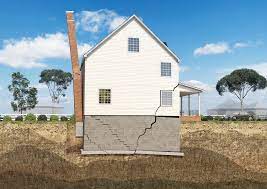The foundation of a building serves as its anchor, providing stability and support. However, the natural forces and environmental conditions that structures face can lead to a phenomenon known as foundation settlement. In this article, we will explore the causes, signs, and potential remedies for foundation settlements, shedding light on a critical aspect of building maintenance and structural integrity.
Understanding Foundation Settlement:
Foundation settlements occurs when a building’s foundation sinks or shifts unevenly into the soil beneath it. This can result from various factors, including soil conditions, construction practices, and environmental influences. As a building settles, it may experience structural issues that, if left unaddressed, can lead to serious damage.
Common Causes of Foundation Settlements:
- Soil Conditions:
- Expansive Soils: Soil with a high clay content tends to expand and contract with changes in moisture levels, exerting pressure on the foundation.
- Poor Compaction: Inadequately compacted soil beneath the foundation can compress over time, leading to settlement.
- Water-Related Factors:
- Excessive Moisture: Poor drainage or prolonged exposure to water can soften the soil, compromising its load-bearing capacity.
- Dehydration: Conversely, drought conditions can lead to soil shrinkage, resulting in voids beneath the foundation.
- Construction Practices:
- Inadequate Footing Design: Foundations with insufficient footings may lack the necessary support, contributing to settlement.
- Improper Grading: Incorrectly graded landscapes can direct water towards the foundation, leading to soil erosion.
- Environmental Factors:
- Freeze-Thaw Cycles: In regions with freezing temperatures, the expansion and contraction of soil due to freeze-thaw cycles can contribute to foundation settlement.
- Seismic Activity: Earthquakes can cause the ground to shift, affecting the foundation’s stability.
Signs of Foundation Settlement:
- Cracks in Walls and Floors:
- Vertical or diagonal cracks in walls and floors, especially near corners, can indicate foundation settlement.
- Doors and Windows Misalignment:
- Doors and windows that no longer align or operate smoothly may be a sign of foundation movement.
- Uneven Floors:
- Sagging or sloping floors, particularly in older structures, may suggest foundation settlement.
- Separation of Exterior Walls:
- Gaps or separations between exterior walls and the foundation can be indicative of settlement.
- Bowed Basement Walls:
- If the walls of a basement or crawl space bow inward, it may be a result of foundation settlement.
- Cracks in Exterior Masonry:
- Brick or masonry exterior may exhibit stair-step cracks or separation due to foundation movement.
Remedies for Foundation Settlements:
- Underpinning:
- Underpinning involves strengthening the foundation by extending it to a more stable soil layer or adding supports beneath existing footings.
- Helical Piers or Screw Piles:
- These are installed beneath the foundation to resist further settlement and, in some cases, lift the structure back to its original position.
- Concrete Piers:
- Concrete piers can be added beneath the foundation to provide additional support and prevent further settlement.
- Grading and Drainage Improvements:
- Correcting the grading around the building and ensuring proper drainage can help manage water-related settlement issues.
- Soil Stabilization:
- Techniques such as soil injection or chemical stabilization can be employed to improve the load-bearing capacity of the soil.
- Water Management:
- Installing proper drainage systems, gutters, and downspouts can help redirect water away from the foundation, minimizing soil-related settlement risks.
Preventive Measures:
- Proper Site Preparation:
- Ensuring proper compaction of soil and adequate site preparation during construction can prevent settlement issues.
- Regular Inspections:
- Regularly inspecting a building for signs of settlement and addressing any issues promptly can prevent further damage.
- Moisture Control:
- Implementing measures to control moisture levels around the foundation, such as proper drainage and landscaping, can mitigate settlement risks.
Conclusion:
Foundation settlement is a common challenge faced by buildings, but understanding its causes, recognizing the signs, and implementing timely remedies are crucial for maintaining structural integrity. Whether through underpinning, pier installation, or soil stabilization, addressing foundation settlements requires a tailored approach based on the specific conditions of the site. With proactive measures and effective solutions, building owners and professionals in the construction industry can navigate foundation settlements, ensuring the longevity and stability of structures for years to come.

